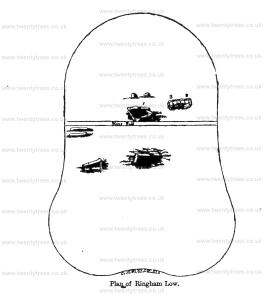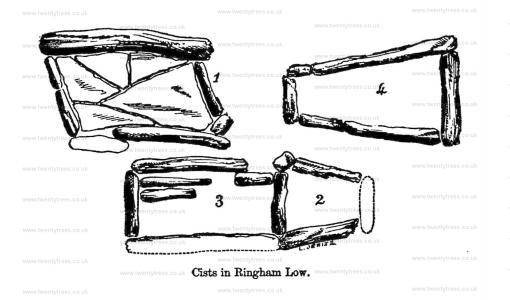Ten Years' Digging 1855
Ten Years' Digging 1855 is in Ten Years' Digging.
Foremark
On the 22nd of May, we examined a few of the very numerous tumuli [Probably [Map]] situated in a plantation called "The Ferns," near Foremark Hall. The locality is a continuation of the eminence called Knoll Hill, and were it not covered by trees, would command an extensive view of the fertile vale of the Trent. The mounds, more than fifty in number, are placed without regularity, but are very uniform in appearance; their size varies from seven to ten yards across, and their average height is from two to three feet. The opening of five of them in places least encumbered with timber, afforded, it is presumed, a complete insight into the manner of interment practised throughout the whole. We found in every instance, that the mound had been raised over calcined human bones, which lay in the same place on the natural surface as they occupied when the funeral pile was smothered out by the casting up of the tumulus. The bones and black ashes of the pyre, reduced by compression to a layer about an inch thick, generally covered a space about four or five feet diameter in the centre; above were accumulated stones bearing marks of fire, which had been first thrown on the glowing embers, and over these earth was heaped to form the bowl-shaped mound. The only indication of man's workmanship brought to light by these researches, were two very small fragments of iron, found with two separate interments, one only having the definite form of a very slender pin, 1¾ inches long.
The origin of this tumular cemetery is enveloped in obscurity, and I fear to express an opinion upon a subject so uncertain, where opinion can be but mere conjecture; the absence of pottery and weapons affording no clue to the age or people to which the sepulchres should be attributed. Yet, taking it for granted that all the mounds would, if opened, reveal the same mode of burial, it would be natural to suppose that no great variation of date, if any, existed as to their age. Inferring further, from the lack of remains of a primitive character, and the presence of the iron fragments in two out of the five mounds opened, I should hesitate in assigning to them a high antiquity; and would rather seek to connect them with the eventful period in which tradition affirms the place to have been the scene of a sanguinary conflict between the Saxons and their Danish enemies, of whose successful forays in the Vale of Trent we have evidence in the name of the adjacent village of Ingleby, as well as in that of the still nearer domain of Foremark.
On the 23d of May, the two circular mounds within the curious embankments in a field called the "Buries," near the Saxon town of Repton, were excavated with a view to ascertain their real character, and that of the earthworks with which they are connected. As an ample description of the place, accompanied by measurements and a ground plan, may be seen at page 259, of Dr. Bigsby's elaborate History of Repton, 4to., 1855, it will be sufficient to place on record, that the present investigation left the question of the intention of the mounds wrapped in as much mystery as ever, with the sole exception of our ascertaining that they covered no sepulchral remains.
The largest was composed of extremely compact earth, which appeared to have been tempered with water when it was cast up, the natural pebbly gravel, mixed with clear sand, was found at the depth of about six feet below the summit of the tumulus. One or two small pieces of coarse kiln-baked pottery, similar to that often met with amongst Romano-British remains, which had evidently been accidentally mixed up with the earth, occurred in the progress of the excavation.
The smaller mound presented results exactly similar as to structure; the only article found was a large iron nail, apparently modem, which lay about a foot from the surface.
Ringham Low![]()
On the 7th of June, we went to the large chambered tumulus near Monyash, called Ringham Low [Map], some of the cists in which had been examined in 1847 (Vestiges, p. 103), for the purpose of investigating a cist that had been accidentally discovered. It was rather north of the centre of the mound, with the ends east and west (No. 1 of the Plan,) and was rhomboidal in shape, measuring eight feet six inches in length, by four feet in width, the sides were mostly formed by four very large stones, one of which was upwards of nine feet long; the bottom was paved with five slabs of limestone pretty well fitted to each other, the average depth was about eighteen indies. It was filled with limestone gravel, and small stones, covering a large quantity of human remains, most of which were in the utmost disorder, though near the bottom they had been less disturbed, and perhaps, in one or two cases, retained their original position. These have since been ascertained to include the remains of twelve individuals, comprising two infants and ten adults, mostly exhibiting the lengthened form of skull I have before observed to be constantly found in tumuli of the same description as the present.
The lower part of the gravel, and the interstices between the paving-stones, abounded with rats' bones; and on removing part of the floor we found that many human bones had been drawn beneath it by these restless creatures. In clearing out these joints we found three very beautiful leaf-shaped arrow points of white-flint, one of which, considering the material, is of wonderful execution; it measures 2¼ inches in length, is an inch broad in the middle, and weighs less than 48 grains, although it is not made from a thin flake, but is elaborately clipped all over both surfaces. We observed fragments of the skulls of oxen, teeth of horses, dogs, &c, but no trace of pottery, although a little charcoal was mixed with the clay on which the pavement rested.

On the 9th of June, we made several cuttings in the northern half of the mound, one only affording traces of interment. A little to the east of the cist examined on the 7th of June, we met with another enclosure contracted in like manner, with three large stones, one end being absent. (No. 2 on the Plan.) It contained the imperfect skeletons of four persons, and the only instrument found was part of a bone pin. This cist having the same orientation as the former, was connected with another similar enclosure extending from its western end, which, owing to the wetness of the day, was not then opened. The dimensions of No. 2 are:-
Presumed length, one end being absent 5ft
Width at east end 2ft 8in.
Ditto west end 4ft
Average depth 2ft
like the cist of the 7th of June, it was paved with limestone slabs.
On the 21st of June, we cleared out the other cist in connection with the last. No. 3 on the Plan. like the others, it had been previously disturbed, and the paved floor had been removed; we found in it the remains of two full-grown skeletons, which had been much broken up, and two very beautiful leaf-shaped arrow heads of white flint, that had escaped the observation of the former diggers. The measurements of this chamber were -
Length 8ft 4in
Average width 3ft
Depth 3ft 6in

On the same day we examined a low mound [Ricklow Dale Barrow [Map]] a short distance east from Ringham Low, in the direction of Ricklow Dale, measuring about 14 yards across. It was so much destroyed as to yield no remains, except two pieces of an extremely thick human skull, and the usual rats' bones; in fact, the whole mound had been removed to within a few inches of the natural surface, on which lay some flat stones.
On the 5th of July, we opened another cist on the south side of the wall, which will be seen from the plan to cross the mound at Ringham Low [Map]. This (No. 4 on the Plan) when emptied, exhibited a fine and perfect specimen of primeval architecture, measuring in
Length 9ft
Width at east end 5ft 6in
Ditto at west end 2ft 6in
Depth 4ft
Six stones only were used in its structure, no pavement having been laid down. We left it in the same perfect state as we found it, having discovered only a few human bones, and a roughly chipped block of hard stone, which were embedded without order in a layer of stiff clay, immediately above the natural rock on which, the chamber was based; and a little charcoal at a higher level near the west end.
All the enclosures have been made by large slabs of limestone from the immediate vicinity, set on edge in narrow channels cut in the natural soil to the required shape of the chamber, and then secured in their respective positions by small stones firmly wedged between their sides and the solid earth. The tumulus in which they are distributed is composed of a vast accumulation of stones of all sizes, and is of irregular shape, as will be seen from the plan; its size may be stated as about 50 yards by 30, and its average height 4 feet.

